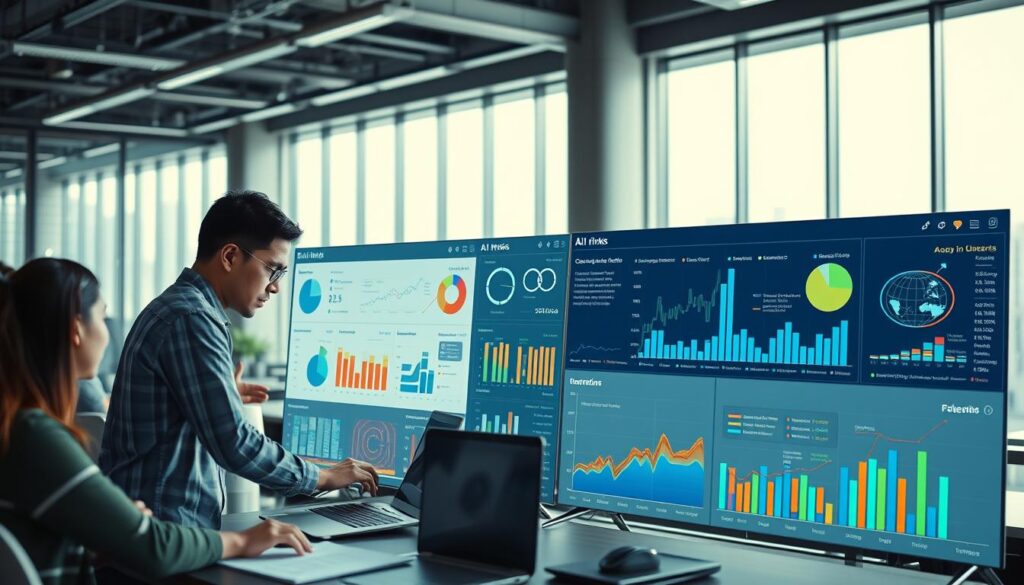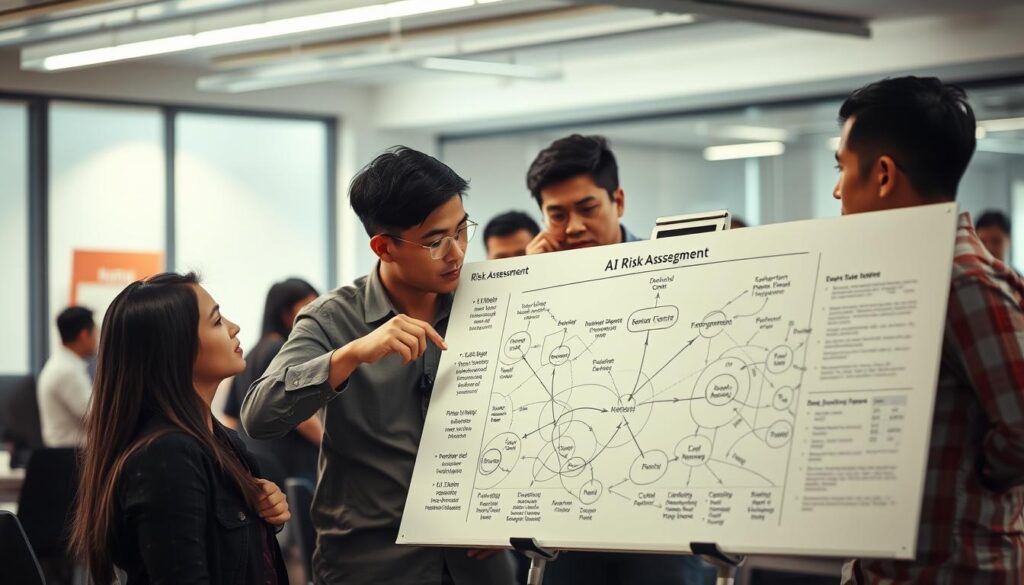Artificial intelligence is changing the world, but are we ready for its risks? As more businesses in the Philippines and Southeast Asia use AI, managing risks is more important than ever. We’ll look at the top AI risk tools to help companies assess risks better. This ensures their projects run smoothly and keeps their operations safe.
Key Takeaways
- Understanding AI risk management is crucial for project success.
- Identifying effective tools can streamline risk assessment processes.
- Organizations can enhance governance through rigorous risk evaluation.
- Real-world applications highlight the effectiveness of these AI tools.
- Implementation challenges must be navigated for optimal outcomes.
Introduction to Risk Assessment in AI Projects
Risk assessment is key in AI project development and use. It helps spot potential dangers and unknowns that could affect success. By knowing these risks, companies can use better tools for managing risks, making smarter decisions and planning.
AI project evaluation looks at many things, like following rules, being technically possible, and what stakeholders want. Doing these assessments early is vital. It helps companies deal with the challenges AI brings. This way, projects can run more smoothly.
Good risk assessment helps projects succeed and lets innovation grow. Using solid risk management methods helps teams build reliable AI. It also tackles the unknowns that come with new tech.
Importance of Risk Assessment in AI
Risk assessment in AI projects is very important. It helps make better decisions and use resources wisely. It also makes sure projects follow the rules.
By looking closely at risks, companies can focus on the biggest ones first. This helps them manage risks better.
Tools for checking risks are key in AI project management. They help spot problems early. This lets businesses be more confident in their work.
Think about data privacy in AI. Regular checks can stop big data problems. Keeping data safe is also very important.
These steps help companies follow the rules and keep trust with others. Teaching employees about data privacy is also crucial.

Having an AI ethics team and clear rules helps reduce risks. Following laws like GDPR and CCPA protects a company’s good name. Using predictive analytics helps spot and prevent problems.
For companies to grow, they must see the value in risk assessment in AI. Good risk management keeps a company safe and encourages new ideas. Learn more about keeping data safe in AI here: resource.
Comprehensive Overview of AI Risk Tools
Today, companies have many AI risk management tools at their disposal. These tools help spot, evaluate, and lessen risks in AI projects. They range from simple templates for first checks to complex software with predictive analytics and live monitoring.
Knowing what AI risk tools do can help companies pick the right ones. Tools for full risk assessment let businesses deeply look into AI risks. This way, they can create strong plans to handle these risks.
| Type of Tool | Functionality | Ideal Use Scenarios |
|---|---|---|
| Basic Risk Assessment Templates | Provide foundational risk analysis frameworks. | Early-stage project evaluations. |
| Predictive Analytics Software | Analyze trends and predict potential risks. | Ongoing evaluations in dynamic environments. |
| Real-time Monitoring Tools | Continuously track and report risk factors. | Projects requiring constant oversight. |
| Compliance Management Tools | Ensure adherence to regulations and guidelines. | Highly regulated industries. |
| Integrated Risk Management Solutions | Combine various risk management functionalities. | Organizations looking for a comprehensive approach. |
By looking into what these tools can do and when to use them, companies can make smart choices. This helps them deal with the challenges of AI projects better.
Key Features of Effective AI Risk Management Tools
Effective AI risk management tools have key features that help spot and tackle risks. A user-friendly interface is crucial, making it easy for teams to work with complex data. Real-time analytics give quick insights into how things are going, helping teams act fast when needed.
Compliance tracking is another vital feature. It keeps an eye on rules and laws, avoiding legal trouble. Customizable reports make sharing important risk management info easier. Automating tasks also boosts efficiency, saving time for more important work.
The NIST AI Risk Management Framework shows how these features are key to a good strategy. As more businesses use AI, these tools are essential for managing risks well.
| Feature | Description | Benefits |
|---|---|---|
| User-Friendly Interface | Streamlined navigation for complex data analysis | Enhanced accessibility for users across departments |
| Real-Time Analytics | Instant insights into AI performance and compliance | Facilitates quick decision-making |
| Compliance Tracking | Monitoring adherence to regulations and standards | Minimizes risk of legal repercussions |
| Customizable Reporting | Tailored reports for stakeholder communication | Improves clarity and project alignment |
| Workflow Automation | Streamlining repetitive tasks and processes | Boosts efficiency, allowing focus on strategic goals |

Top AI Tools for Risk Assessment
In the world of AI risk management, some tools really stand out. They help make risk evaluation and management easier. This ensures strong protection against threats. Here are five top AI risk tools, with their main features and uses.
1. RiskWatch
RiskWatch offers a full platform for risk evaluation with advanced analytics. It watches risks in real-time, helping organizations tackle vulnerabilities quickly. Users can see risk data clearly on customizable dashboards, making better decisions.
2. Previse
Previse is all about quick and reliable risk assessments in AI projects. It uses machine learning to spot issues early and suggest fixes. This helps businesses stay compliant and reduce risks.
3. LogicGate
LogicGate is known for its easy-to-use interface. It lets teams create and change workflows easily. It works well in many industries, making risk management smooth. It also helps teams work together well.
4. CyberGRX
CyberGRX has a global risk exchange platform. It changes how companies check third-party risks. It offers clear insights, building trust with partners. Users get access to a wide range of risk information.
5. RiskSense
RiskSense combines threat intelligence and security analytics. It gives a complete view of risks. It helps focus on risks that matter most, based on business impact. It’s great for integrating different data sources.
Real-life Applications of Risk Assessment Tools
AI risk management in Asia has shown how risk assessment tools can change organizations. Companies have used these tools to find and fix problems. They also make better decisions.
Success Stories from Asian Companies
Many big companies in Asia have started using AI risk management. This has made a big difference for them.
- Siemens in the Philippines used advanced tools to improve their making process. They cut down on downtime and mistakes a lot.
- Samsung set up a strong risk management system for their supply chain. This helped them predict better and use resources wisely. They became more efficient and saved money.
- Alibaba used AI tools to boost their security. They were able to fight off threats and keep customer data safe.
These stories show how risk assessment tools can help. They can make companies more innovative and competitive in Asia.

Risk Management & Governance in AI Projects
Risk management is key to AI project success. A strong governance framework helps spot and tackle risks early. This boosts risk management and keeps it in line with business goals.
Good AI project governance means everyone talks clearly. This lowers the chance of surprises. In places like the Philippines, following local rules is vital. A solid governance system helps meet these standards, keeping AI projects honest.
Putting focus on risk management builds a culture of openness and responsibility. This lets teams keep an eye on risks and change plans when needed. With a good governance setup, teams can make smart choices that avoid big problems.
| Governance Aspect | Description | Benefits |
|---|---|---|
| Framework Establishment | Setting up policies and processes for AI risk management | Ensures compliance and clarity among stakeholders |
| Stakeholder Communication | Facilitating discussions and updates between involved parties | Reduces misunderstandings and enhances collaboration |
| Continuous Monitoring | Regularly assessing risks throughout the project lifecycle | Allows for timely adjustments and proactive management |
Challenges in Implementing AI Risk Tools
Using AI risk tools can be tough for companies. They often hit AI tools implementation obstacles that slow down progress. One big problem is when staff resist change, sticking to old ways.
Training and support are key to help staff get used to new tech. This makes the transition smoother.
Another challenge is fitting new AI tools into existing systems. Many companies face complex setups that don’t work well with new tech. Choosing tools that easily fit in can help a lot.
Keeping data safe and accurate is also a big deal. Companies need strong data rules to protect info and build trust in AI.
It’s important for companies to tackle these issues head-on. This way, they can improve their risk management with AI.

Best Practices for Risk Assessment in AI Projects
To improve risk assessment in AI projects, organizations should follow best practices. These strategies make risk management more effective. One important step is to conduct pilot tests with small teams. This allows for feedback to make necessary adjustments.
It’s also crucial to train users well. When all team members know how to use tools and processes, they can spot and fix risks early. Keeping data safe is another key area. Strong security measures are needed to protect sensitive information.
Regularly checking how tools perform helps improve them. Getting feedback from users helps adapt to new challenges. These steps help build a proactive risk culture in AI projects.
| Best Practices | Description |
|---|---|
| Conduct Pilot Tests | Engage small teams to provide feedback and make necessary adjustments before full rollout. |
| Provide Thorough Training | Equip users with the knowledge to effectively navigate tools and processes. |
| Ensure Robust Data Security | Implement strong protection measures to secure sensitive data throughout the project lifecycle. |
| Regularly Review Tool Performance | Gather user feedback to continuously improve and adapt risk assessment tools. |
Conclusion
Effective risk management is key for AI project success, more so in the Philippines and Southeast Asia. As businesses use advanced AI, it’s crucial to have good risk assessment tools. These tools help spot problems early and guide smart decisions, keeping projects on track.
Strong risk management strategies protect businesses from unexpected issues. Taking proactive steps lets companies fully use AI, leading to growth and staying ahead in a changing market.
Success in AI comes from careful planning and focusing on risk management. Companies that do well use AI to improve their work and serve their customers better.

